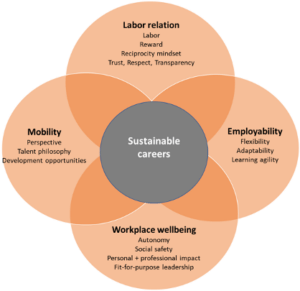Fit-for-purpose workforce
The challenge of a fit-for-purpose workforce is to align jobs and people to where value is being created, and, to enable a mechanism to develop fit-for-purpose skills and behaviors. This is about balancing organizational and employees’ ambitions and expectations, and, looking at it from a strategic and holistic point of view.
Continuos improvement is better than delayed perfection.
Mark Twain
I support organizations to balance their (future) capability needs with employees’ aspirations, through development and deployment of coherent policies, processes, tools, and interventions.

Strategic Talentmanagement
Attracting, developing, and retaining talent is one of the most important challenges right now.
Strategic talent management is about defining your future need for talent and about taking actions to meet these needs. What is the future talent-need of your organization? How to identify talent and how to create appealing talent propositions to attract and retain talent?
Talent management that focuses on the long-term success of employees and organizations complements the focus on future talent-needs with internal mobility, flexibility, and, wellbeing of employees.
Sustainable careers
A sustainable career is one that endures over time through the entire work lifecycle; so it applies to the current organization and beyond.
How will it be possible for workers to stay happy, healthy and productive in the long term in a workplace environment that keeps changing and is often unpredictable? And what does it mean for organizations to facilitate employability, workplace wellbeing and mobility?
We know it requires a holistic approach and shared responsibility and ownership: both organization ánd employee need to invest in the labor relationship, employability, mobility and workplace wellbeing. But how?
One of the instruments to support building sustainable careers is the Career Fitness Profiler (CFP). It is an evidence-based questionnaire to facilitate conversations related to talent and succession management, career development, mobility, and stress/wellbeing. The CFP is developed and validated by the University of Antwerp,
I am a certified Career Fitness Profiler assessor and coach.

Learning & development
Developing people is about positioning them for growth, ideally at the intersection of their passions and the needs of their organization.
Building (future) capabilities
As we enter a new decade of increasing digital transformation and accelerating pace of change, it is more important than ever to help your employees build the (future) skills they need.
But what are the most critical soft and hard skills that your organization is looking for? How to close existing and future skills gaps effective and efficient ? How to accelerate digital savviness? And how to develop and deliver personalized development solutions that also increase employee engagement?
Building a fit-for-purpose corporate academy
To be able to deliver tailored, effective, efficient, and scalable solutions that contribute to the organizational strategy, an academy should be fit-for-purpose herself. But is she?
Are the L&D policies, technologies, processes, and tools fit-for-purpose? And how about the L&D professionals? How can L&D as a function impact business results and how to measure that impact? What is the ROI on your development investments and how to maximize it? And how to us data for the benefit of the Academy and the organization?
Train people well enough so they can leave. Treat them well enough so they don’t want to.
Sir Richard Branson

